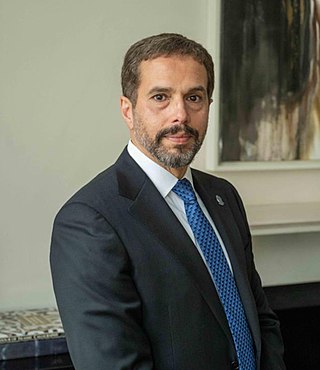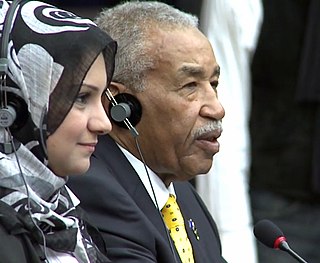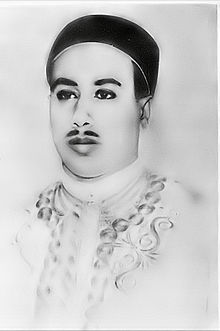
The Senusiyya, Senussi or Sanusi are a Muslim political-religious Sufi order and clan in Libya and surrounding regions founded in Mecca in 1837 by the Grand Sanussi, the Algerian Muhammad ibn Ali al-Sanusi.

Idris was King of Libya from 24 December 1951 until his ouster in the 1 September 1969 coup d'état. He ruled over the United Kingdom of Libya from 1951 to 1963, after which the country became known as simply the Kingdom of Libya. Idris had served as Emir of Cyrenaica and Tripolitania from the 1920s until 1951. He was the chief of the Muslim Senussi Order.

The national flag of Libya was originally introduced in 1951, following the creation of the Kingdom of Libya. It was designed by Omar Faiek Shennib and approved by King Idris Al Senussi who comprised the UN delegation representing the three regions of Cyrenaica, Fezzan, and Tripolitania at UN unification discussions.

Mohammed El Senussi is the son of Crown Prince Hasan as-Senussi of Libya, and of Crown Princess Fawzia bint Tahir Bakeer. Born in Tripoli, he is considered by Libyan royalists to be the legitimate heir to the Senussi Crown of Libya.

The Kingdom of Libya, known as the United Kingdom of Libya from 1951 to 1963, was a constitutional monarchy in North Africa that came into existence upon independence on 24 December 1951 and lasted until a bloodless coup d'état on 1 September 1969. The coup, led by Muammar Gaddafi, overthrew King Idris and established the Libyan Arab Republic.

Italian Tripolitania was an Italian colony, located in present-day western Libya, that existed from 1911 to 1934. It was part of the territory conquered from the Ottoman Empire after the Italo-Turkish War in 1911. Italian Tripolitania included the western northern half of Libya, with Tripoli as its main city. In 1934, it was unified with Italian Cyrenaica in the colony of Italian Libya. In 1939, Tripolitania was considered a part of the Kingdom of Italy's 4th Shore.

Sayyida Fatimah el-Sharif, after marriage Fatimah as-Senussi, was Queen of Libya as the wife of King Idris from 1951 until the 1969 Libyan coup d'état.

The Libyan People's Court is an emergency tribunal founded in Libya after the revolution of 1 September 1969. Although its initial purpose was to try the officials of the overthrown Kingdom, many others also were tried by this court. This article discusses only the trial of officials of the Kingdom.

The 1951 Libyan Constitution was brought into force on October 7, 1951, prior to Libya's formal declaration of its independence on December 24, 1951 as a constitutional and hereditary monarchy under the rule of King Idris. The enactment of the Libyan Constitution was significant in that it was the first and only piece of legislation that formally entrenched the rights of Libyan citizens after the post-war creation of the Libyan nation state.
Idris bin Abdullah al-Senussi is a member of the family of Idris, Libya's former UN-appointed king. While the family of Idris, appointed king of Libya by United Nations General Assembly, was under house arrest after Muammar Gaddafi overthrew his rule, Prince Idris al-Senussi began working on leading the family and uniting Libya, as this role was passed onto him by his late father. The position of heir to the short-lived Libyan throne is also claimed by his cousin Prince Mohammed El Senussi, the son and designated heir of the last Libyan Crown Prince.

During the early stages of the Libyan Civil War of 2011, the Gaddafi regime was still in power: but there was widespread withdrawal of support for that regime by influential persons and organisations within the country. Among those who no longer supported the regime, the main concern they expressed was about what they regarded as its use of excessive force against peaceful protestors. There were resignations by many ministers of the governing council and other senior officials, diplomats posted abroad, and senior military officers. Islamic clerics, tribal leaders, and members of the former royal family expressed their opposition, while the two leading Libyan oil companies also withdrew support for the regime.

Prince Ahmed Al-Zubair al-Senussi, also known as Zubeir Ahmed El-Sharif is a Libyan member of the Senussi house and a member of the National Transitional Council representing political prisoners.

The Libyan Armed Forces or the Libyan Arab Armed Forces are, in principle, the state organisation responsible for the military defence of Libya, including ground, air and naval forces.

Libyan nationalism refers to the nationalism of Libyans and Libyan culture. Libyan nationalism began to arise with the creation of the Senussi religious orders in the 1830s that blended North African Sufism with orthodox Islam. After colonization of Libya by Italy, opponents of Italian colonial rule from Tripolitania and Cyrenaica combined forces in 1922, with Senussi leader Omar Mukhtar leading the revolt against Italian forces in Libya. Libya became an independent state after World War II.

The 1969 Libyan revolution, also known as the al-Fateh Revolution or 1 September Revolution, was a coup d'état and revolution carried out by the Free Officers Movement, a group of Arab nationalist and Nasserist officers in the Libyan Army, which overthrew the Senussi monarchy of King Idris I and resulted in the formation of the Libyan Arab Republic. The Free Officers Movement was led by Colonel Muammar Gaddafi.
The Movement for the Return of Constitutional Legitimacy – Zliten seeks to reinstate the 1951 Constitution of Libya, proclaiming it a symbol of the sovereignty of the nation and a guarantor of unity. Zliten is one of the several cities within Libya that is actively involved in the larger movement, the Movement for the Return of Constitutional Legitimacy in Libya.
The Movement for the Return of Constitutional Legitimacy - Tripoli is an active campaign in Libya’s capital and largest city, Tripoli, to reinstate the 1951 Constitution and the historic Senussi monarchy. Members of the movement view the 1951 Constitution as the only political solution to the Libyan Civil War that has persisted since 2011. The members of the movement advocate for the legitimate heir to the Senussi Crown Prince Mohammed El Senussi, son of Crown Prince Hasan as-Senussi and nephew of late King Idris, to lead Libya according to the provisions of the 1951 Constitution.
The Movement for the Return of Constitutional Legitimacy in Libya is a movement in Libya that advocates the reinstatement of the 1951 Constitution and the restoration of the historic Senussi monarchy.
The expulsion of Italians from Libya took place following 21 July 1970, when the Libyan Revolutionary Command Council (RCC) issued a special law to "regain wealth stolen from the Libyan people by Italian oppressors", as stated by Muammar Gaddafi in a speech a few days later. With this law, Italians who had long lived in Libya were required to leave the country by October 1970.

The Free Officers movement was a group of Arab nationalist and Nasserist officers in the Libyan Army that planned and carried out the 1969 Libyan coup d'état, which overthrew the Senussi monarchy of King Idris I, ending the Libyan monarchy. It was led by a twelve-member cabinet known as the Revolutionary Command Council, whose chairman was Muammar Gaddafi, which came to govern the Libyan Arab Republic.













